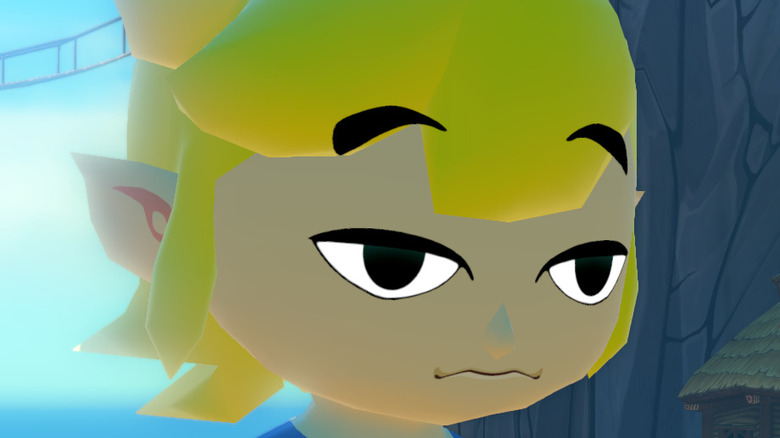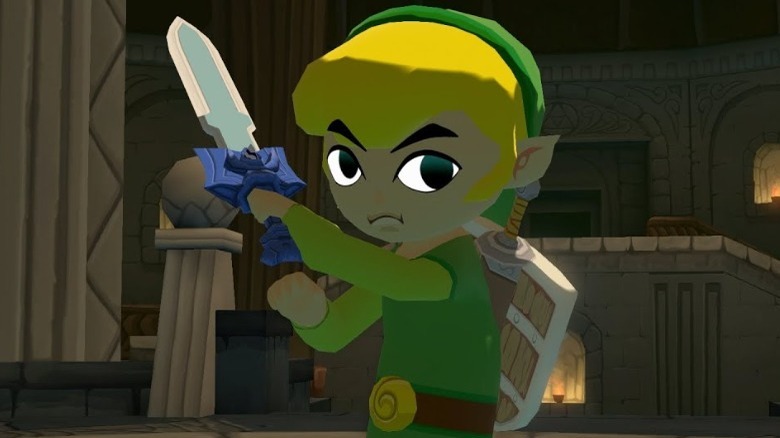Shigeru Miyamoto 'Literally Cringed' When Seeing The Legend Of Zelda: Wind Waker's Art Style
Among the most praised games in the "Zelda" catalogue is "The Legend of Zelda: The Wind Waker," but it wasn't always popular, especially among diehard fans. The main reason for this is because the Gamecube exclusive "The Wind Waker" was the first title in the "Zelda" franchise to have a cel shaded aesthetic. In 2022 Toon Link is something of a fan favorite character that most look back fondly on, it wasn't always that way. Even producer and Nintendo Legend Shigeru Miyamoto initially thought it was a mistake to go with a cartoony art direction for "The Wind Waker."
The decision to make it cel-shaded rather than realistic ultimately helped it stand the test of time, but it wasn't just fans of "The Legend of Zelda" who didn't like the game's now-iconic art direction. According to DidYouKnowGaming, which translated several interviews with game director Eiji Aonuma earlier this year, it took a great deal of convincing to get Miyamoto on board with the idea of a cartoon "Zelda" game. In fact, according to Aonuma, the Nintendo legend couldn't hold back his reaction and "literally cringed" when he was first shown the game's art style.
Miyamoto really wanted a realistic Zelda
DidYouKnowGaming has been around for a long time, and it's no stranger to translating long-forgotten documents in search of more interesting behind-the-scenes trivia. Back in June 2022, the channel uploaded an exclusive which went over revelations uncovered from the now-defunct Nintendo Dream Magazine and other translated sources from when the game was initially released. The exclusive highlights director Eiji Aonuma's comments on getting Shigeru Miyamoto on board with the development team's cel-shaded, stunning transformation of "Zelda."
He explained that he waited until the game was deep in development before unveiling it to Miyamoto, to avoid having to remake it all more realistically. After he had to give a presentation on the game, Miyamoto reportedly told Aonuma that it wasn't too late to make "The Wind Waker" more realistic. Ultimately Miyamoto came around to the idea, in part because it could have taken up to a decade to remake a more realistic version of "The Wind Waker." There were two direct sequels to "The Wind Waker" on the Nintendo DS in the same style — "Spirit Tracks" and "Phantom Hourglass" — so he must have become pro-cel-shading at some point.
The art style itself wasn't really the main issue, it was Nintendo's apparent 180 turn away from a realistic "Zelda" prototype that was revealed years before. Because its visuals were completely opposite to what the company showed off at Nintendo Spaceworld in 2000, the game drew a lot of ire from fans, who were led to expect an HD follow-up to the Nintendo 64 games.
The visuals of The Wind Waker were divisive
Cel-shading was becoming quickly more popular around the time of "The Wind Waker" release as a method of making games look better without making it harder to run. It's a trend that's continued to be popular across all genres, but the cartoony visuals of "The Wind Waker" weren't always the plan. At Nintendo Spaceworld 2000, and at E3 2001, a tech demo for the GameCube was shown off with short snippets of upcoming Nintendo games — including "Luigi's Mansion," "Metroid Prime," and "Super Mario Sunshine."
A new "Zelda" game was shown here too, depicting Ganondorf and Link fighting in a more realistic style than predecessor "Majora's Mask." Two years later, after virtually no news about this unannounced "Zelda" game, Nintendo revealed "The Wind Waker." When comparing the two, it's easy to see why the cartoon style disappointed fans and Miyamoto — everyone was expecting an HD "Zelda," but ended up feeling lied to by Nintendo's E3 demo. We may never know what truly happened to this tech demo "Zelda" game, but some say it was eventually turned into the darker "Twilight Princess."
Over time, more "Zelda" fans gave the game a chance and discovered its charm and unique approach to its world. Since its release, that initial disappointment and divisiveness turned to broad praise, and Nintendo has adopted cel-shading for several other games, including "Breath of the Wild."


